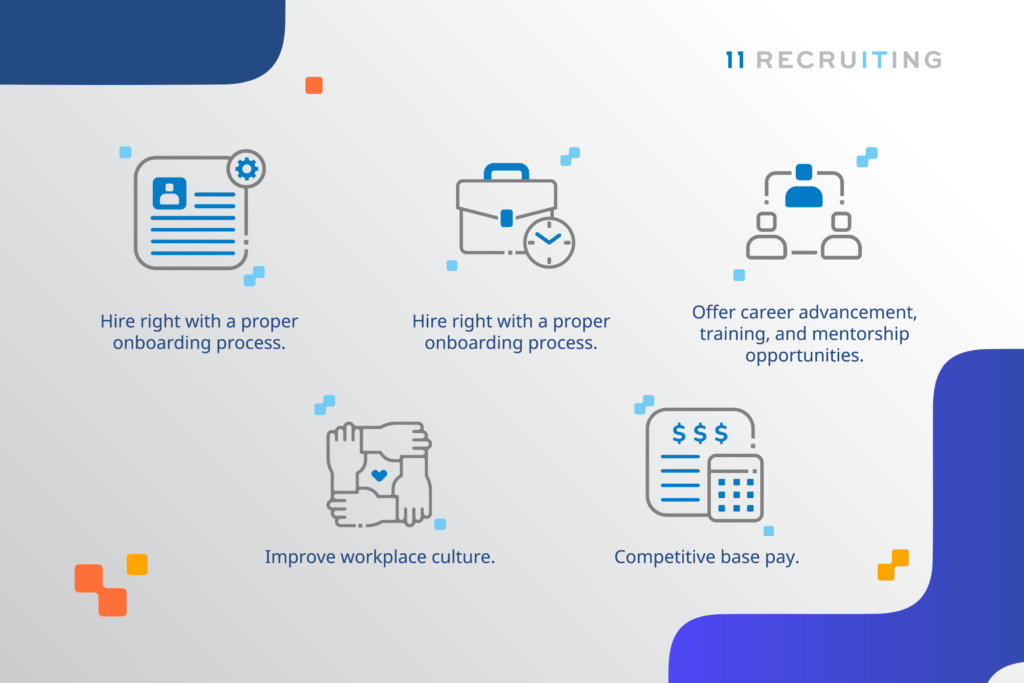
In March 2022, a record-breaking number of 4.536 million people left their jobs; a huge increase from the 3.695 million in March 2021. Poor employee retention strategies are to blame, and today, retaining employees has become a business-focused area as the cost of employee turnover can range from tens of thousands of dollars to 1.5–2.0x the employee’s annual salary.
While it’s true that the pandemic changed how we work, there are still some ways we can improve employee retention. The list below highlights some of the best employee retention strategies for 2022.
If this sounds interesting to you, eleven recruiting is brimming with topics and experience on hiring and retaining professionals and entry-level candidates. Head on to our services page to speak to our recruiters.
Frequently Asked Questions
What are employee retention strategies?
Employee retention strategies are organization plans and procedures created to keep their current employees as long as possible to reduce employee turnover rates. These strategies often include company policies and programs that should be based on the specific needs of each employee.
What are some factors that can affect employee retention?
Career growth potential, work-life balance, and team support can have a massive effect on employee retention. Satisfaction and culture are also great indicators of an employee’s loyalty. When the salary pay, compensations, and benefits packages don’t compliment an employee’s efforts, expect to see a high employee turnover rate.
How can a company choose the best employee retention strategies to use?
First, you need to analyze and evaluate your workforce to know where you’re headed and what work needs to be done. You can then meet and ask your employees (individually) for feedback to get a feel for what might get them to stay. After the feedback, consider what each employee values most and make improvements in line with that factor.
What are some intrinsic and extrinsic values offered to employees?
Some intrinsic motivators that can boost employee retention are autonomy and trust (core to employee engagement), a sense of inclusion, equity and meaningfulness, a positive work culture, recognition and rise for accomplished tasks, and acquiring new skills.
Some external motivators that can boost employee retention are a competitive salary, employee benefit packages, a flexible work schedule that gives work-life balance. Additionally, you must understand employee-specific motivators. It won’t make sense to spend all your time incentivizing outstanding performance through external motivators, primarily when an employee’s motivation lies within.
Why are employee retention strategies essential?
One significant benefit of good employee retention strategies is that it helps organizations save hiring costs and cost of employee turnover by reducing the frequency of hiring new staff. It also helps to boost employee productivity, morale, and job satisfaction. A retention strategy that includes rewarding employees for hitting milestones can make employees feel more appreciated for their hard work and encourage them to always put in more effort.
Five Employee Retention Strategies
Employees often stay when they feel valued, appreciated, and cared for by their employees. Employers could prevent 3 in 4 employees from leaving. So much more than the employee benefits packages, here are five strategies companies can use to decrease the employee turnover rate in 2022.

1. Hire right with a proper onboarding process.
It’s also essential to start off with hiring the right people and giving them the proper onboarding process. Research shows that organizations with a positive onboarding experience increase new hire retention by 82% and improve new employee productivity by 70%. Limit your focus on only hard skills during the hiring process, and be sure to look out for soft skills, such as adaptability, active listening, empathy, and collaboration.
Be transparent and honest to the new hires about their role during the hiring process, and vet candidates carefully to see if they fit well with the company culture, managers, and co-workers and how their values align with the company. You wouldn’t want to hire someone who cheats when your company is rooted in honesty.
2. Offer flexible and hybrid work schedules.
54% of people surveyed by zip recruiters prefer a flexible job, and 74% of the US workforce are willing to quit a job just to work from home, which was expected after the covid period. Employees stay when they are given the chance of a flexible or hybrid work schedule that allows them to spend more time with their families and children, deal with personal life issues, and have the option to work in the office at their own convenience. You create a win-win offer by offering a flexible or hybrid work schedule. You’ll be saving costs to rent and infrastructure while your employee will be saving time, money for commuting, and fewer distractions for a better work-life balance.
FACT: 86% of employees say they would prefer to continue working from home or with a hybrid schedule even after offices reopen.
3. Offer career advancement, training, and mentorship opportunities.
Another critical aspect of employee retention strategies is creating opportunities for career advancement for your employee. Employees stay when they are given a career path that lets them move up their career ladder, pursue new opportunities with new challenges and get a higher paycheck with your company. They are 12x more likely to leave due to perceived barriers to career growth. An actionable tip is to create “in-role” growth opportunities, in-house training programs, mentorship programs, offer learning management systems, outside seminars, or computerized training, especially for remote employees.
You can stratify entry-level positions into six positions instead of two or three. This way, employees can advance by a level every six months rather than wait two to three years. And If you’re unsure of the training opportunities that suit your employees, ask them how they learn best to help them excel in the company.
FACT: According to LinkedIn Learning Report, 94% of employees would stay longer with employers who helped them learn
4. Improve workplace culture.
Glassdoor research studies show that company culture matters more for long-term employee retention, satisfaction, and engagement because there is almost always going to be a rival organization that could potentially pay your best people more. Company culture encompasses many things, but the emphasis is often on diversity, inclusion, and equity.
Your employees won’t last if you don’t create the conditions for them to stay. An actionable step is to give your employee some form of autonomy by reducing favoritism, eliminating gender pay gap, and treating each employee at every level with equal measures of respect and dignity. You can also encourage regular feedback or ask specific questions about employee treatment at work to know if they feel comfortable with the work culture and if it aligns with their values.
FACT:
Nearly 50% of Black and Hispanic employees have quit a job due to discrimination, and 70% of Black and Hispanic employees feel that their employer should do more work improving inclusion and diversity in the workforce.
5. Competitive base pay.
45% of employees who quit reported that their top reason for leaving was unsatisfactory pay. An essential facet in employee retention strategies and actionable steps towards employee retention is to offer employees their desired salary based on their skills, experience, and geographical location or higher if resources are available and if they deserve it.
Employees are often looking out for competitive benefits. You could also use employee benefits packages such as insurance, retirement-saving plan, flextime, cell phone stipends, or memberships to the clubs of their choice to make up for a less competitive salary.
While these five employee retention strategies are the core to employee retention, you should also encourage your employees to take time off to destress and focus. Employee retention also starts at the leadership level, so leaders should be transparent about essential factors concerning the organization across all levels of the organizational ladder.
If possible, conduct exit interview questions to understand the driving factors behind an employee’s decision to leave and “stay interviews” with existing employees to understand why they want to work for their company, the things they feel could be improved about the company, and what it will take to keep them.
To sum up
Employee retention strategies aren’t one-time exercises, so it’s essential to evaluate your plan annually. Make it difficult for your employees to leave by taking strategic approaches to hiring and giving a proper onboarding process to your new hires to avoid the cost of a bad hire.
You should also stay current and flexible about new and innovative employee benefit packages and salary standards. Be open to offer career advancement programs for your new hires and existing hires, and remember to embrace work-life balance for everyone working in the organization.

